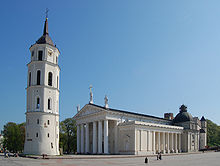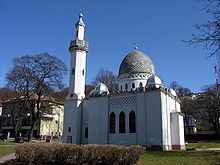- Religion in Lithuania
-
The Religion in Lithuania is predominantly Catholic, reflecting Lithuania's history, with a strong presence from other minorities. According to the most recent Eurobarometer Poll 2005,[1]
- 49% of Lithuanian citizens responded that "they believe there is a God"'.
- 36% answered that "they believe there is some sort of spirit or life-force".
- 12% answered that "they do not believe there is any sort of spirit, God, or life-force".
Contents
Population by religious confession
- Roman Catholics - 79% (2,752,447 people)
- Orthodox Believers - 4.05% (141,821)
- Old Believers - 0.77% (27,073)
- Evangelical Lutherans - 0.56% (19,637)
- Evangelical Reformists - 0.2% (7,082)
- Jehovah's Witnesses - 0.1% (3,512)
- Sunni Muslims - 0.08% (2,860)
- All Gospel Churches - 0.06% (2,207)
- Pentecostal Church - 0.04% (1,307)
- Jews - 0.04% (1,272)
- Balts Believers - 0.04% (1,270)
- Baptists (and other independent churches) - 0.04% (1,249)
- Other believers - 0.135% (4,701)
- Not any - 9.5% (331,087)
- Not indicated - 5.35% (186,447) (2001 census)[2]
Christianity
Roman Catholicism
79% of Lithuanians belong to the Roman Catholic Church.[3] Roman Catholicism has been the majority denomination since the Christianization of parts of Lithuania proper in 1387 (the Highland) and in 1413 (Samogitia, the Lowland).[4]
Some Catholic priests led the resistance against the Communist regime which continued after independence against socialism and liberalism, especially in ethical questions.
The Hill of Crosses near Šiauliai, a shrine to the anti-communist resistance, was where thousands of Latin Rite crosses were placed. Latin crosses were forbidden on the hill by the Czarist, Russian Orthodox, authorities in 19th century. The Soviet authorities continued the prohibition. Despite being bulldozed in 1961 the planting continued and Pope John Paul II visited the hill during his visit to Lithuania.
Eastern Orthodoxy
Eastern Orthodoxy claims 4.1 % of the population, mainly the Russian minority.[3]
Protestantism
Protestants makes up 0.8% of the population, mainly the Evangelical Lutheran Church of Lithuania.[3]
In the 16th century, Protestantism started to spread from Western Europe. A united reformed church organization in Lithuania's church province can be counted from the year 1557 at the Synod in Vilnius on December 14 of that year. From that year the Synod met regularly forming all the church provinces of The Grand Duchy of Lithuania, at first from two and later growing to six districts and representative district synods. The abbreviated name for the church is in Latin, Unitas Lithuaniae or in Polish, Jednota Litewska (Lithuanian church provincial union). It sent its representatives to the General Polish/Lithuanian Synods; however in its administration it was in fact a self-governing Church. The first Superintendent was Simonas Zacijus (Szymon Zacjusz, approx 1507–1591). In 1565 the anti- Trinitarian Lithuanian Brotherhood who rejected the learning of the Trinity separated from UL. The UL parish network covered nearly all of The Grand Duchy. Its district centers were Vilnius, Kedainai, Biržai, Slucke, Kojdanove and Zabludove later Izabeline.
Small Protestant communities are dispersed throughout the northern and western parts of the country. Samogitia was historically positioned between the two German-controlled states of Livonia to the north and the Protestant formerly monastic, Teutonic State of Prussia to its south. In the 16th century, from those two regions Lutheranism started to spread into the country. The majority of Prussian Lithuanians living in East Prussia and in Memelland (what is now the Klaipėda Region of modern Lithuania) were members of the Evangelical Church of the old-Prussian Union, and most of them were resettled in the Federal Republic of Germany along with the rest of the East Prussian German inhabitants after World War II. Since 1945 Lutheran Protestantism in Lithuania has declined.
Various Protestant churches have established missions in Lithuania since 1990, including the United Methodists,[5] the Baptist Union,[6] the Mennonites,[7] and World Venture.[8]
Islam
In Lithuania, Islam has a long history unlike many other northern European countries. The medieval Grand Duchy of Lithuania of the Polish–Lithuanian Commonwealth allowed Muslims, notably the Crimean Tatars to settle in the lands in the south.[9] Some of people from those lands were moved into ethnically Lithuanian lands, now the current Republic of Lithuania, mainly under rule of Grand Duke Vytautas. The Tatars, now referred to as Lithuanian Tatars, lost their language over time and now speak Lithuanian as natives; however, they have strongly maintained their Muslim faith.
Judaism
According to the 2001 census, there were 1,272 adherents of Rabbinic and Karaite Judaism.[10]
Karaites
According to a Karaite tradition several hundred Crimean Karaites were invited to Lithuania by Grand Duke Vytautas to settle in Trakai ca. 1397. A small community remains in Trakai today, which has preserved the Turkic Karaim language and distinctive customs, such as its traditional dish called "kibinai", a sort of meat pastry, and its houses with three windows, one for God, one for the family, and one for Grand Duke Vytautas.
Romuva
A neo-pagan Romuva, established in 1967, attempts to reconstruct ancient Lithuanian mythology.[11]
See also
References
- ^ European Union. "Eurobarometer on Social Values, Science and technology 2005 - page 11" (PDF). http://ec.europa.eu/public_opinion/archives/ebs/ebs_225_report_en.pdf. Retrieved 2007-05-05.
- ^ Census 2001: Population by Religious Confession
- ^ a b c (Lithuanian) "Romos katalikų daugiausia". Department of Statistics to the Government of the Republic of Lithuania. 2002-11-07. http://www.stat.gov.lt/uploads/docs/2002_11_07.pdf.
- ^ Foreword to the past: a cultural history of the Baltic people by Endre Bojtár, p. 140
- ^ (English) United Methodists evangelize in Lithuania with ads, brochures
- ^ (English) Baptist beginnings in Lithuania.
- ^ (English) Graduation: Lithuania Christian College
- ^ (English) World Venture. Lithuania.
- ^ Islamic peoples of the Soviet Union, by Shirin Akiner, pg. 85
- ^ (Lithuanian) "Gyventojai pagal tautybę ir tikybą". Department of Statistics to the Government of the Republic of Lithuania. http://db.stat.gov.lt/sips/Dialog/varval.asp?ma=gs_dem21lt&ti=Gyventojai+pagal+tautyb%E6+ir+tikyb%E0++&path=../Database/cen_lt/s71lt/1.%20demografija/&lang=1.
- ^ A history of pagan Europe by Prudence Jones, Nigel Pennick, p. 173
Religion in Europe Sovereign
states- Albania
- Andorra
- Armenia
- Austria
- Azerbaijan
- Belarus
- Belgium
- Bosnia and Herzegovina
- Bulgaria
- Croatia
- Cyprus
- Czech Republic
- Denmark
- Estonia
- Finland
- France
- Georgia
- Germany
- Greece
- Hungary
- Iceland
- Ireland
- Italy
- Kazakhstan
- Latvia
- Liechtenstein
- Lithuania
- Luxembourg
- Macedonia
- Malta
- Moldova
- Monaco
- Montenegro
- Netherlands
- Norway
- Poland
- Portugal
- Romania
- Russia
- San Marino
- Serbia
- Slovakia
- Slovenia
- Spain
- Sweden
- Switzerland
- Turkey
- Ukraine
- United Kingdom
- (England
- Northern Ireland
- Scotland
- Wales)
States with limited
recognition- Abkhazia
- Kosovo
- Nagorno-Karabakh
- Northern Cyprus
- South Ossetia
- Transnistria
Dependencies
and other territories- Åland
- Faroe Islands
- Gibraltar
- Guernsey
- Jan Mayen
- Jersey
- Isle of Man
- Svalbard
Other entities Categories:
Wikimedia Foundation. 2010.



